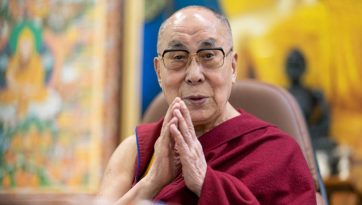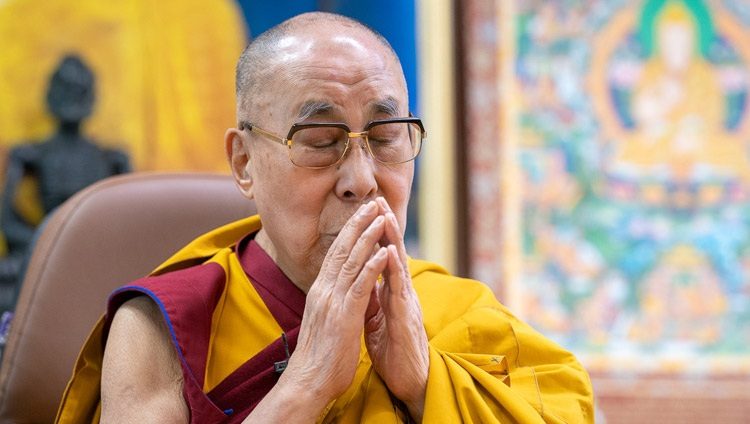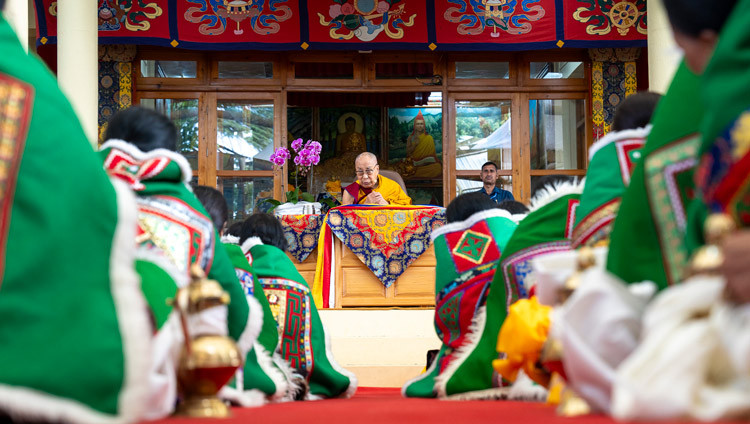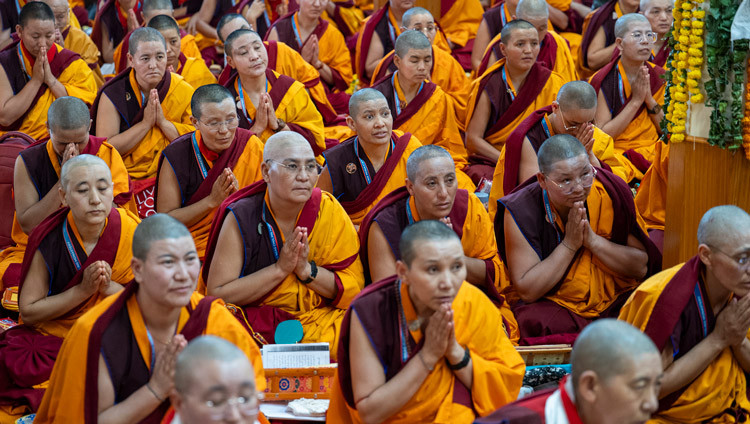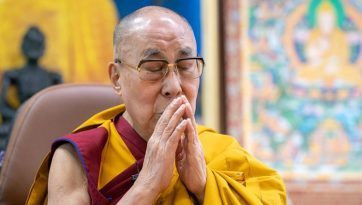Lamp for the Path to Enlightenment—Second Day
July 14, 2021
Thekchen Chöling, Dharamsala, HP, India – This morning, at his residence, His Holiness the Dalai Lama entered the room, waved to the audience he could see on the screens before him, and sat down. Meanwhile, at Thiksé Monastery in Ladakh, Thiksé Rinpoché performed prostrations and made a mandala offering and other members of the audience gathered in the Leh Jokhang.
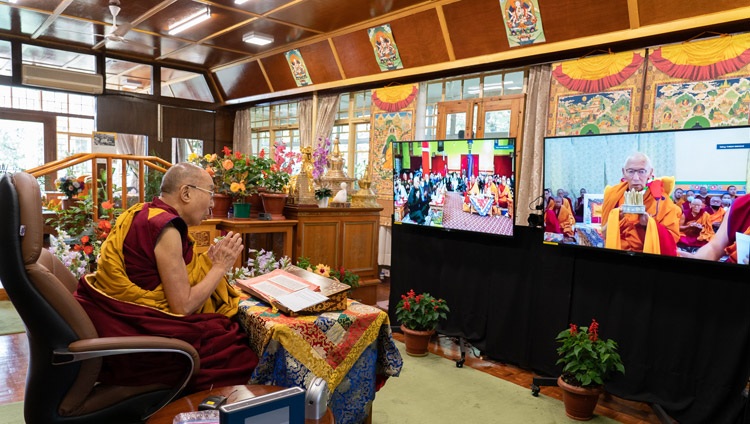
“Today is the fourth day of the sixth month of the Tibetan lunar calendar,” His Holiness announced. “It’s an auspicious day on which we commemorate Buddha Shakyamuni’s first turning the wheel of dharma. First, we’ll go through the remaining part of the text we were reading yesterday and then I’ll conduct a ceremony for cultivating bodhichitta.
“As I said previously, when we’re concerned with a dharma discourse not only must the teacher have a pure motivation, those listening to him or her should also be inspired to attain enlightenment for the sake of others.
“These days, in our materially advanced world, where so much thinking is guided by science and there is so much material development, we may ask ourselves how religion is relevant. The answer is that no matter how much material development we may have, by itself it doesn’t bring us mental peace. Material development is necessary, but we also need peace of mind. Inner peace is not produced by machines, nor is it the result of an injection or other medical intervention. To achieve peace of mind we need to train the mind. We need to understand what disturbs our minds and how those disturbances can be countered.
“Among scientists I’ve met are those who have little interest in past and future lives but who regard meditation, compassion, a calmly abiding mind and insight as intriguing and useful.
“There are many religious traditions in the world and among their followers many seek peace of mind by praying to god. Another approach, fostered in ancient India, involves coming to understand the workings of our minds and emotions. It has grown along with the practices of ‘karuna’, compassion and ‘ahimsa’, doing no harm.
“Supported by different philosophical ideas, the Buddha taught a rational method to counter those factors that, rooted in our selfish attitude, disturb our peace of mind. The ancient Indian practices of compassion and doing no harm have to do with the mind. They are not limited to physical conduct. We harm others in other ways because our minds are undisciplined. In Buddhism we say, a disciplined mind is happiness and unhappiness is an undisciplined mind.
“All religions teach warm-heartedness, love and compassion, but Buddhism has the broadest, most profound instructions for achieving peace of mind. You Ladakhis are followers of the Buddha and maintain your faith in the dharma whatever political changes take place around you. In the past, monasteries were mostly concerned with performing rituals, but in more recent times, like the monks of Namgyal Monastery here in Dharamsala, you have taken my advice to study more rigorously.
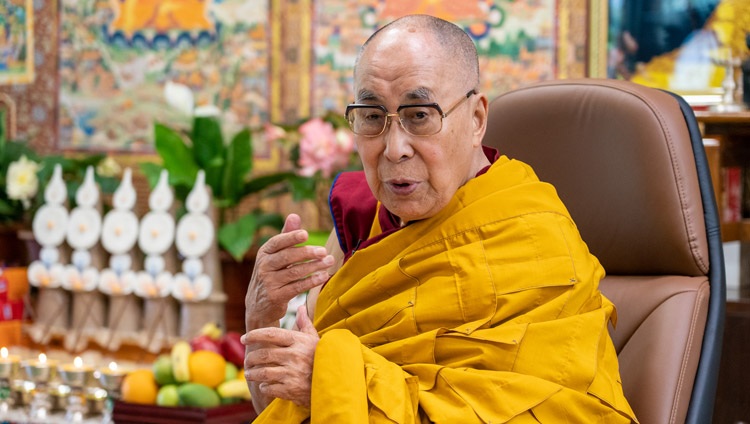
“We talk about the lineages of extensive conduct, profound view and blessings from experience. In the Sanskrit tradition, as preserved in Tibet and the Himalayan Region, we have a rich literary heritage including 100 volumes of translations of what the Buddha taught, more than 200 translated volumes of teachings by subsequent masters in India and tens of thousands of commentaries by Tibetan masters. We have the richest collection of the Buddha’s teachings to be found anywhere. And in a world where the minds of so many people are disturbed, the teachings contained in these books remain extremely relevant.”
His Holiness took up the text of ‘Lamp for the Path to Enlightenment’ and noted that calm abiding, which enables the mind to focus single-pointedly on its object, also brings with it pliancy of body and mind. He remarked that since we currently have the opportunity to practise, we should do so. The text states: ‘While the conditions for calm abiding are incomplete, meditative stabilization will not be accomplished, even if you meditate strenuously for thousands of years.’
He clarified that ‘shamatha’, calm abiding, and ‘vipashyana’, insight, are not differentiated by the object on which they focus. Both can be employed in the development of the awakening mind and the wisdom realizing emptiness. Nevertheless, although you may have cultivated compassion and bodhichitta, what actually counters grasping at true existence is the wisdom understanding emptiness.
As the text says: ‘To eliminate all obstructions to liberation and omniscience, the practitioner should continually cultivate the perfection of wisdom with skilful means’. If understanding of emptiness is linked only to the wish to attain liberation, it will lead to arhatship. But if it is coupled with the awakening mind, it will lead to omniscience. It is when wisdom is backed by bodhichitta that it can overcome the obstructions to knowledge. Therefore, the text counsels linking wisdom with the other perfections—generosity, ethics, patience, effort and concentration.
Whoever, under the influence of familiarity
With skilful means, cultivates wisdom
Will quickly attain enlightenment —
Not just by meditating on selflessness. 46
His Holiness mentioned that his own practice has been based for many years on cultivating the awakening mind of bodhichitta and an understanding of emptiness. Because of this he says he draws great inspiration from three powerful verses at the end of chapter six of Chandrakirti’s ‘Entering into the Middle Way’.
Thus, illuminated by the rays of wisdom’s light,
the bodhisattva sees as clearly as a gooseberry on his open palm
that the three realms in their entirety are unborn from their very start,
and through the force of conventional truth, he journeys to cessation. 6.224
Though his mind may rest continuously in cessation,
he also generates compassion for beings bereft of protection.
Advancing further, he will also outshine through his wisdom
all those born from the Buddha’s speech and the middle buddhas. 6.225
And like a king of swans soaring ahead of other accomplished swans,
with white wings of conventional and ultimate truths spread wide,
propelled by the powerful winds of virtue, the bodhisattva would cruise
to the excellent far shore, the oceanic qualities of the conquerors. 6.226
He went on to discuss three further verses, 34, 35 and 36, also from chapter six of same text, which he reflects on daily. (A summary of the discussion is taken here from ‘Illuminating the Intent’).
If the intrinsic characteristics of things were to arise dependently,
things would come to be destroyed by denying it;
emptiness would then be a cause for the destruction of things.
But this is illogical, so no real entities exist. 6.34
If the inherent characteristic of a thing such as form or feelings were to arise in dependence upon causes and conditions, through its own essence, this would imply that a yogi directly perceiving the emptiness of inherent existence of all phenomena would realize emptiness by denying such a nature of things. Meditative equipoise does not actually perceive form and so on, but if they were to exist through their inherent characteristics, then meditative equipoise would necessarily perceive them. It does not. And if this were so, these things would then become non-existent. If they do become non-existent, it would then be the case that what was existent prior to the meditative equipoise would subsequently come to be destroyed or ceased. The meditative equipoise would become the cause for their destruction. So just as hammers and the like are causes for the destruction of vases and the like, seeing emptiness too would then be a cause for the destruction of the nature of things, thus denigrating them. But this is illogical, so no real entities exist—that is, say, by virtue of their inherent characteristics—and we must never uphold such a notion of inherent arising.
Thus, when such phenomena are analysed,
nothing is found as their nature apart from suchness.
So, the conventional truth of the everyday world
should not be subjected to thorough analysis. 6.35
When such phenomena as form, feelings, and so on are analysed thoroughly, in terms such as “Does it arise from itself or does it arise from other?” beyond the fact they do not arise or cease on the ultimate level—that is, apart from suchness as their nature—nothing else is found, no other or extra dimension such as arising and so on. So, the conventional truth of the everyday world should not be subjected to thorough analysis in terms such as “from itself, from other,” and so on. We should just accept the facts of worldly perception, captured in statements such as “If this exists, that follows.” We should do this on the basis of participating in the conventions that are dependent on others—those of the world.
In the context of suchness, certain reasoning disallows arising
from self or from something other, and that same reasoning
disallows them on the conventional level too.
So, by what means then is your arising established? 6.36
In the context of an analysis into suchness or the ultimate truth, certain reasoning presented above disallows the arising of phenomena such as form from self or from something other. Likewise, on the conventional level too, that same reasoning disallows them—the arising of form and so on through inherent characteristics. So, by what means of valid cognition then is your inherent arising established? It is not.
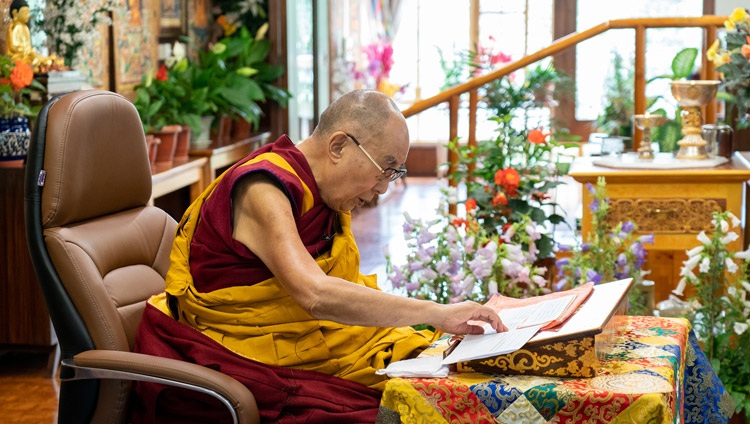
“Things will continue to appear to have objective existence,” His Holiness continued, “but experience will confirm that they do not exist in that way. They are like illusions. As your experience of emptiness increases, your experience of the illusion-like nature of things will also grow. It is an error to say that not existing inherently by way of its own entity is equivalent to not existing at all.”
Citing a verse from the text: ‘Just as wisdom does not see an inherent nature in phenomena, having analysed wisdom itself by reasoning, meditate on that non-conceptually,’ His Holiness encouraged his listeners to integrate what they learn from the teaching into their own practice.
He mentioned that among Buddhist schools of thought, the Particularists – Vaibhasikas and Sutra Followers – Sautrantikas teach selflessness. The Mind Only School – Chittamatra assert that there is no external existence, but that the mind has some existence from its own side. Only the Middle Way Consequentialists – Prasangikas assert that things have no objective existence at all.
His Holiness recalled reporting his experience of emptiness to Ling Rinpoché, who was his principal philosophy teacher. He responded that His Holiness had gained the proper insight and before long would become a ‘space-yogi’. His Holiness observed that change doesn’t come about in a matter of days, but can be seen over a period of years.
The final verses of ‘Lamp for the Path’ deal with the practice of tantra, which His Holiness reiterated is based on experience of bodhichitta and the wisdom understanding emptiness. When it comes to Highest Yoga Tantra, not only do you need to depend on calm abiding and insight, but you need to employ inner energies through practices such as the nine-round breathing. Highest Yoga Tantra involves using the channels, winds and energies. Consequentially, once the 80 conceptions have dissolved, 33 related to the whitish appearance, 40 connected with reddish increase and seven involved with black near attainment, you’ll manifest the clear light mind.
Atisha states that celibate monks should not take the secret and wisdom initiations. Monks do not take a mudra or consort who is a human being, but they do follow the practice of using the vital energy, bringing it down to the tip of the secret place and back up again to the crown chakra so developing spontaneous bliss.
Having completed his reading and explanation of ‘Lamp for the Path’, His Holiness announced that he would conduct a ceremony for cultivating bodhichitta. He instructed his listeners to visualize the Buddha in the space in front of them flanked on the right by Manjushri, who can help dispel the darkness of ignorance and on the left by Arya Tara, who can provide solace and protection from sickness during the time of this pandemic. He described other figures to include in the visualization and led the congregation in reciting the verses for cultivating bodhichitta, followed by verses of celebration.
Finally, His Holiness answered questions from the audience. Asked how to address the extremism and polarization that seem so widespread in the world today he first touched on religion. He affirmed that all religious traditions teach the virtues of altruism. To serve others requires compassion and love. The important point, if you choose to be religious, he said, is to take the tradition seriously. It’s not enough to just pay lip service to a set of customs.
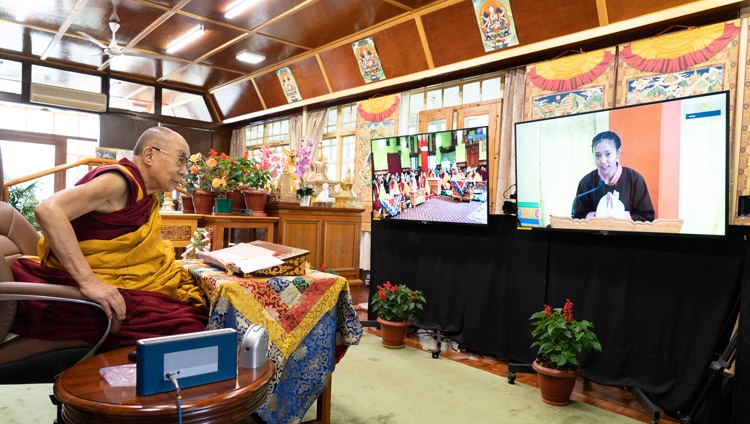
He touched on the prevalence of democracy, the system that enables us to choose and elect our leaders, as well as holding them accountable. The more altruistic those leaders are, the greater the benefit they will bring. When they are merely cunning and selfish, they do little good for the community. He concluded, “You are one, others are many; serve the many”.
His Holiness clarified that within the great vehicle of the Sanskrit tradition, the beings of three capacities, lesser, middling and great, are not different people. They refer to stages on the path.
Invited to comment on people’s turning to drink and drugs for support, His Holiness declared that if you turn to drink it has the result of limiting your ability to employ your natural intelligence. Drink and drugs may give some short-term gratification, but in the long run, they not only don’t help, they cause damage. If you are unhappy, a more effective solution is to reflect on the drawbacks of self-cherishing and the advantage of concern for others.
Concerning conventional existence His Holiness cited Choné Lama Rinpoché as saying, “Dependence does not deny suchness; arising does not deny worldly convention.” The Buddha taught dependent arising and the two truths. Things appear to exist, which is conventional reality. Ultimate reality is how they exist.
When a young woman confessed that anger comes easily to her and that she wanted to know how to deal with it, His Holiness responded that anger is a strong emotion, but it is not founded on reason. He recommended that she ask herself, ‘How does anger help?’ We become angry out of frustration. However, we don’t have to give in to it. We live in societies on whom we depend. If we become angry with our neighbours, we’ll be the losers. Look at things from a broader perspective, he suggested, and cultivate patience. He encouraged the questioner to read chapters six and eight in particular of Shantideva’s ‘Entering into the Bodhisattva’s Way’ and ended by telling her anger never helps.
A young Muslim woman wanted to know how His Holiness accounts for his popularity with followers of religions other than Buddhism.
“Perhaps it’s because I talk about the importance of cultivating a good heart,” he told her, “which is a theme common to all religious traditions. Every religion teaches about the faults of giving in to anger and the advantages of love, and these are things I talk about too. I stress the importance of working to foster religious harmony. But perhaps most significant of all, I smile and I laugh. You don’t see me with a stern look on my face. I think of other human beings as my brothers and sisters, and I pay special attention to the oneness of humanity.”
As the teaching session came to an end, Thiksey Rinpoché offered His Holiness thanks.
“You have most graciously given us an explanation of the Great Jowo Atisha’s ‘Lamp for the Path to Enlightenment’ online. On behalf of the entire people of Ladakh, we would like to thank you for your immense kindness to us.
We would like to request Your Holiness to visit us in Ladakh next year.
“There is also an increasing interest in the Dharma, logic and reasoning, and so forth. This, Your Holiness, has come about solely due to your kindness.
“I have completed the construction of the Sherab Kyetsal Ling Education Centre and Library where we are now giving free education to 300 students from different schools in Ladakh. They attend our 45-day teaching on secular ethics. We have also prepared a curriculum for the schools to include in their teaching. We offer all of them free of cost.
“Finally, I pray that Your Holiness will live a steadfast and healthy life without the slightest obstacle. Tashi Delek.”

